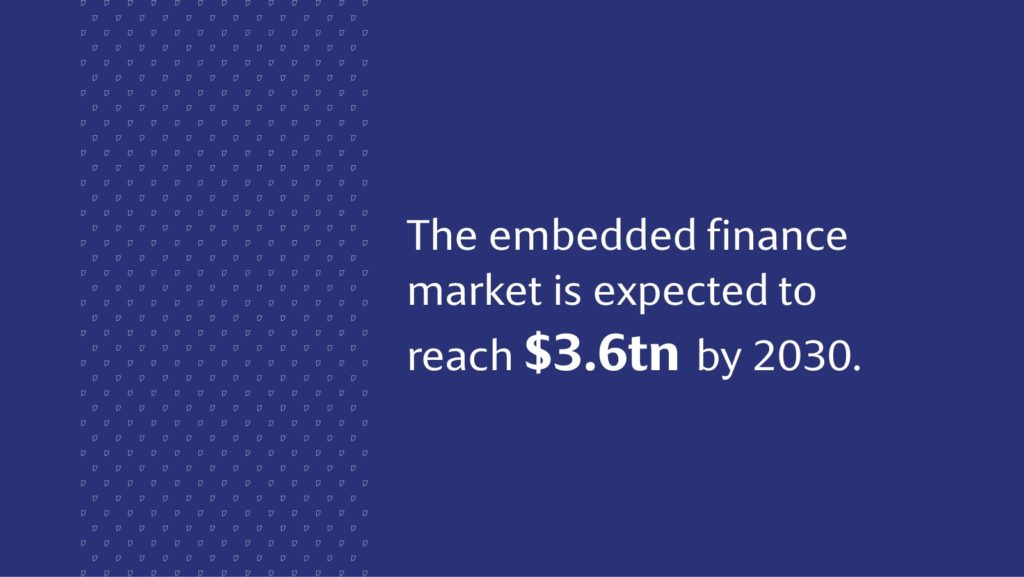From retailers and airlines, to ride-sharing apps and coffee chains, brands are embedding financial services into their online and mobile offerings to increase revenues, build customer loyalty and gain deeper insights about them. This is starting to gain real momentum across the world, particularly among Gen-Z consumers looking for seamless and integrated online experiences in their daily lives. For incumbent banks and new entrants alike, this presents new opportunities to adopt the banking-as-a-service (BaaS) business model – the seamless provision of complete banking processes such as loans, deposits or payments through an API, from a real-time cloud-native technology platform using a licensed bank’s secure and regulated infrastructure to deliver the financial service directly at the point of customer need – i.e. embedded finance.
The embedded finance market is expected to reach $3.6tn by 20301. An increasingly popular use case is Buy Now Pay Later which has upended the concept of traditional customer lending by shifting the economics from interest spreads from customers, to commissions from merchants or brands.
But this BaaS opportunity is one that incumbent financial institutions, often struggle to capture, because of innate technology challenges they must first overcome.

Breaking the legacy logjam – digital transformation on steroids
The message is clear: embedded finance is the future of banking services and BaaS is the future of banks and financial services institutions.
The forward-thinking BaaS players are leveraging modern banking platforms, packaged banking capabilities, and the ability to compose solutions for customers from across an ecosystem of software and application providers using open banking frameworks. While platforms can power the openness to embrace and orchestrate the collaborative ecosystem, it is equally critical to have the advanced technology foundations of open APIs, cloud and SaaS needed to design, distribute and manage the new breed of banking services, at scale.
Yet open banking and BaaS have been relatively slow to take off at incumbent banks in most markets because of constraints imposed by their legacy monolithic IT architectures. To break this legacy logjam, banks must accelerate their digital transformations using disruptive technologies. They must move to functionally rich core banking systems founded on distributed, cloud-native IT architectures. Doing this brings them two key capabilities: firstly, to provide differentiating digital experiences for customers, and secondly, to establish open API marketplaces that realize the full opportunities from open banking. BaaS partnerships and direct provision of banking services take these capabilities to a whole new level.
Eight vital technology attributes
There are eight technology attributes that these new architectures must possess to support open banking and BaaS.
- Openness and interoperability: Beyond the ability to consume and share APIs, banks and BaaS providers must also be able to adapt their APIs rapidly to changing market and regulatory requirements. Advanced developer portals are a prerequisite.
- Modularity: BaaS’s plug-and-play, pay-as-you-go service model makes it imperative to have a microservices-based architecture that allows independently deployable services to be launched quickly.
- No/Low code hyper-personalization: BaaS enables brands or embedded finance portals to personalize and differentiate their offerings. This requires software with preconfigured, extensible and re-usable features.
- Data aggregation & data quality: To develop personalized propositions and provide valuable insights to their ecosystem partners, banks must aggregate and analyze a mass of open banking data in real time. The scalability of cloud is key in doing this.
- Agility and time-to-market: Open banking requires banks to connect fast and seamlessly with ecosystem partners. So BaaS providers need the agility to scale their APIs on demand, to enable rapid product launches and expansion into new geographies. Modern software packages come with configuration, migration and extension APIs for fast incremental implementation.
- Hyper-scalability, resilience and availability: When banks open up data access to third parties, they must handle a surge in queries on their data and provide 24*7 real-time access for third parties’ end-customers. Also, brands consuming BaaS require industrial-strength resilience with zero outages.
- Security: Open banking exposes customers’ personal and financial data to increased risk of unauthorized access. Public cloud infrastructures and cloud-native software provide comprehensive security against cyberattacks.
- Software-as-a-service (SaaS): This enables banks and other FS providers to consume, manage and maintain packaged software on a secure, continually evolving, self-service platform – while also developing specific banking models at their own pace. For BaaS providers, SaaS complements and supports the BaaS consumption model.
Ready for the new world?
An open platform for composable banking demonstrates these eight attributes, including modularity. A bank or BaaS provider that opts for an open platform for composable banking will be well-placed for success in the era of open banking and BaaS. Those holding back will find themselves slipping ever further behind.
Join the winners by transforming to modern cloud-native and API-first technology. To find out more, read our whitepaper, Open Banking and The Rise of BaaS.
1According to Bain Capital Ventures and 11:FS, assuming 40% of payments, 20% of lending and insurance volumes move from traditional banking to embedded finance by 2030.
BaaS technology attributes